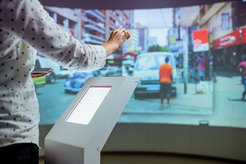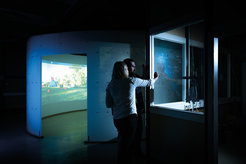THE DATARAMA
Advancing Immersive Data Visualization for the Social Sciences
- completed -
The DATARAMA offers an immersive 360° projection environment for up to 25 people, enabling interactive exploration and simultaneous management of diverse types of data. These include research materials, which combine photography, film and video, archival sources, geo-coded maps, statistics, data visualizations, and websites.
The Datarama
A Multimedia-Tool for Research, Teaching and Presentation
Film realised by the video team of the Niedersächsische Staats- und Universitätsbibliothek Göttingen,
Management: Ralf Köster • Edited by Benjamin Bühring and Dr. Katrin Pietzner, Public Relations, Göttingen University.
Within this walk-in tool, research teams can select and simultaneously juxtapose, analyze and present different types of data, as well as virtually recreate research settings. In this way, the DATARAMA facilitates unique insights and understandings of the way that different forms of social science data are interrelated and spatially conditioned. Within the DATARAMA, researchers and lecturers can combine, analyze, and present research materials in powerful and unprecedented ways.

The DATARAMA © MPI-MMG, 2019.
This unique and exciting new technology holds great potential for fundamental breakthroughs in the social sciences (and other disciplines). Current technologies, such as monitors, video projectors and traditional multi-display arrays, do not provide adequate resolution and display capacities needed for dealing with large and complex datasets. Capturing, analyzing, and presenting massive datasets present a considerable methodological challenge: besides indexing, segmenting and comparing complex information, users without a computer science background are often overwhelmed by workflows involving multiple data formats. Authoring of presentations requires effective amalgamation of interactive elements, such as field notes, videos, real-time data sources, Internet resources, and printed materials. The DATARAMA software facilitates the handling of a large number of audio-visual data sources with the assistance of intelligent automation and data processing, and opens up access to interaction with these by means of innovative input and control concepts. By removing technological barriers to the creation of immersive content, the DATARAMA offers unprecedented opportunities for researchers to organize, analyze, and present their research.
The Datarama – Interactive Virtual Environment
The DATARAMA is comprised of two parts. The first is the rotunda, an all-round, self-supporting projection screen (2.8 m high with a radius of 6 m). The projection cylinder consists of 102 deep-drawn Corian modules and is spanned by an aluminum truss, which carries the projection unit consisting of six video projectors and a server PC. A 1.2 m high control panel is located in the middle of the rotunda and allows alternative forms of data interaction by means of a touch-sensitive surface and gesture control.
The second component is the hardware-agnostic software stack. This software, developed at the Institute, consists of several web applications connected by means of an event-driven architecture:
- Immersive panoramic views of photographs and videos, as well as simulated environments and 3D-objects (these can also be complemented by soundscapes);
- Support of geographic metadata and geo-referenced photo and video material;
- Support for diverse formats and types of visual data: Photographs, diagrams, maps, video and audio material, animations, simulations, text-based sources, and websites;
- Various interaction modes, including an intuitive, gesture-based user interface for selecting, commenting, and filtering data by time, context, and location;
- Faceted browsing for drilling-down and focusing on selected data or visual details;
- Enhanced ability to encode and query information by tags/metadata;
- Real-time visualization of ongoing research and data collection, providing new opportunities for project management and development;
- Event-based server-client architecture that allows multiple clients, including remote clients, to create, modify, and interact with the same datasets;
- Hardware agnostic capacity, i.e., the software can be used on other viewing devices, such as computer monitors and trays, digital projectors, and new formats (e.g., VR headsets like Oculus Rift and Google Cardboard);
- Graphics driver providing calculations of the transformational matrix for distortion-free projection of visual data onto a curved surface.

The DATARAMA © MPI-MMG, 2019.
The DATARAMA arises out of an ERC Advanced Investigator award to Prof. Vertovec. The Max Planck Society granted an additional €1.4 million to develop the DATARAMA in multiple ways. This includes further technical innovation, and the development of the project and exhibition CompleXities: Transformative Urban Ideas from the (rest of the) World, which examines ways that major urban challenges are being tackled in numerous cities of the Global South. The DATARAMA team at MPI-MMG is also working with colleagues at several external institutions to create DATARAMA exhibitions and research capacities, including the Senckenberg Naturkundemuseum Görlitz, the Landesmuseum Hannover, and the Futurium in Berlin.

